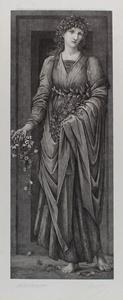| Method | Etching |
| Artist | Eugene Gaujean after Sir Edward Coley Burne-Jones |
| Published | Copyright 1894 by Thomas Agnew & Sons, 39 Old Bond Street, London, Printed in Paris by A. Salmon & Ardail |
| Dimensions | Image 427 x 163 mm, Sheet 585 x 325 mm |
| Notes |
Impression on vellum. Signed by artist and engraver. Bears PSA Stamp. This engraving is based upon one of a pair of tapestries held at the Whitworth Art Gallery in Manchester. A full length classically inspired depiction of a figure representing 'Flora' from a design for a pair of tapestries Burne-Jones worked on alongside William Morris and Company. Flora and Pomona were the first two Morris and Company tapestries for which Burne-Jones designed the figures in 1884. Flora appears bare-foot, cradling a bunch of freshly picked wild flowers with her left arm, in the folds and drapery of her skirt, her right hand grasping more with a scattering of loose flowers surrounding her feet. Her gaze is drawn off to the right with her loose wavy hair held back by a floral wreath head-dress. In Roman mythology, Flora is a Sabine-derived goddess of flowers, a goddess of youth and the season of spring, a symbol for nature and flowers. While she was a relatively minor figure in Roman mythology, being one among several fertility goddesses, her association with the spring gave her particular importance at the coming of the season. Sir Edward Coley Burne-Jones, 1st Bt (1833-1898) was a painter and designer closely associated with the later phase of the Pre-Raphaelite movement. Burne-Jones met William Morris as an undergraduate of Exeter college, Oxford, whilst studying for a degree in theology. The pair went on to work very closely together on numerous decorative arts projects including stained glass windows, tapestries and illustrations. Originally intending to become a church minister, Burne-Jones never finished his degree, choosing instead to pursue an artistic career under the influence of Dante Gabriel Rossetti. Rossetti heavily inspired his early work, but by the 1860's his idiosyncratic style was beginning to develop. His mature work, however different in total effect, is rich in conscious echoes of Botticelli, Mantegna and other Italian masters of the Quattrocento. Thusly, Burne Jones' later paintings of classical and medieval subjects are some of the most iconic of the Pre-Raphaelite movement. He was at the height of his popularity during the 1880's, though his reputation began to decline with the onset of the Impressionists. He was created a baronet in 1894, when he formally hyphenated his name. Eugene Gaujean (1850 – 1900) was a French engraver and etcher. Engen's 'Dictionary of Victorian Engravers...' states he was a pupil of Pils, Vernet-Lecomte, Martinet, and engraved for books and popular periodicals and had works exhibited at the Salon between 1877-1894, winning the gold medal at the Paris Exposition Universelle in 1900. He engraved several of the works of the Pre-Raphaelites including Dante Gabriel Rossetti's 'A Christmas Carol' and Sir Edward Coley Burne-Jones's 'Flamma Vestalis'. Condition: Professionally backed onto archival board. Toning to vellum sheet edges. Foxing to sheet edges. Framed in a plain period frame. |
| Framing | framed |
| Price | £3,500.00 |
| Stock ID | 50513 |

